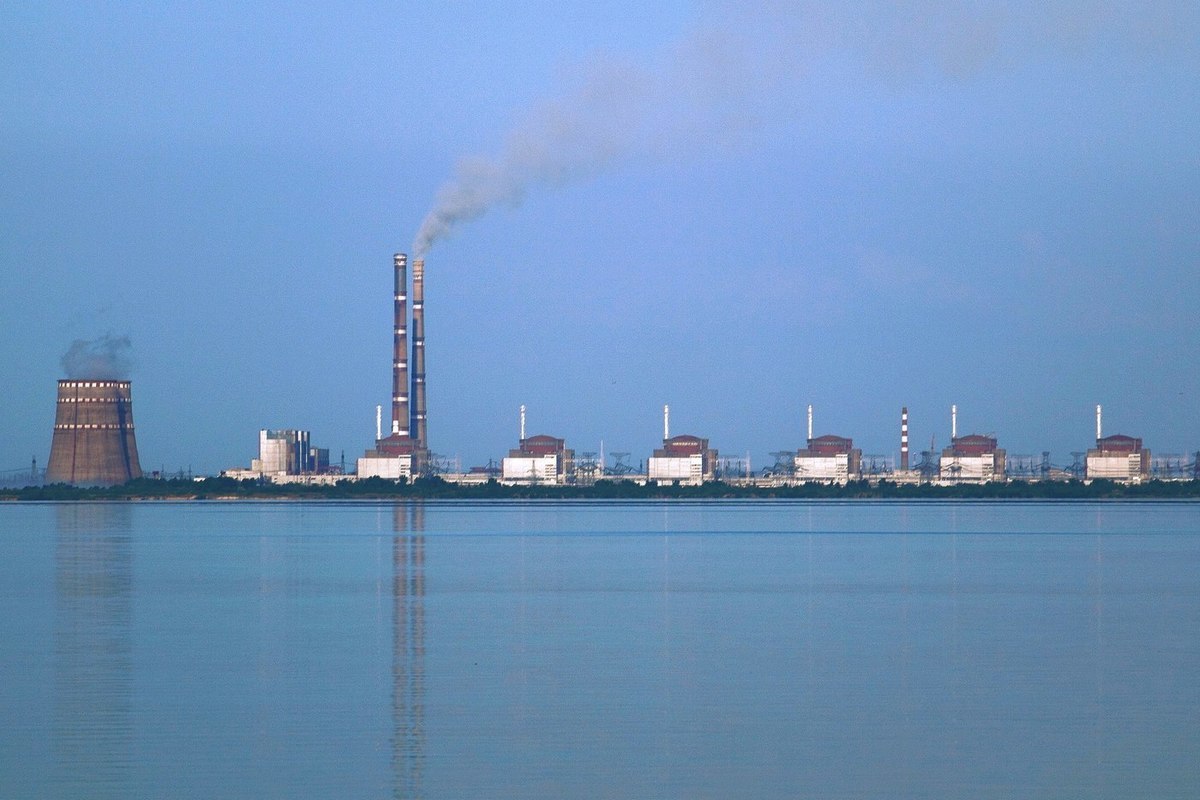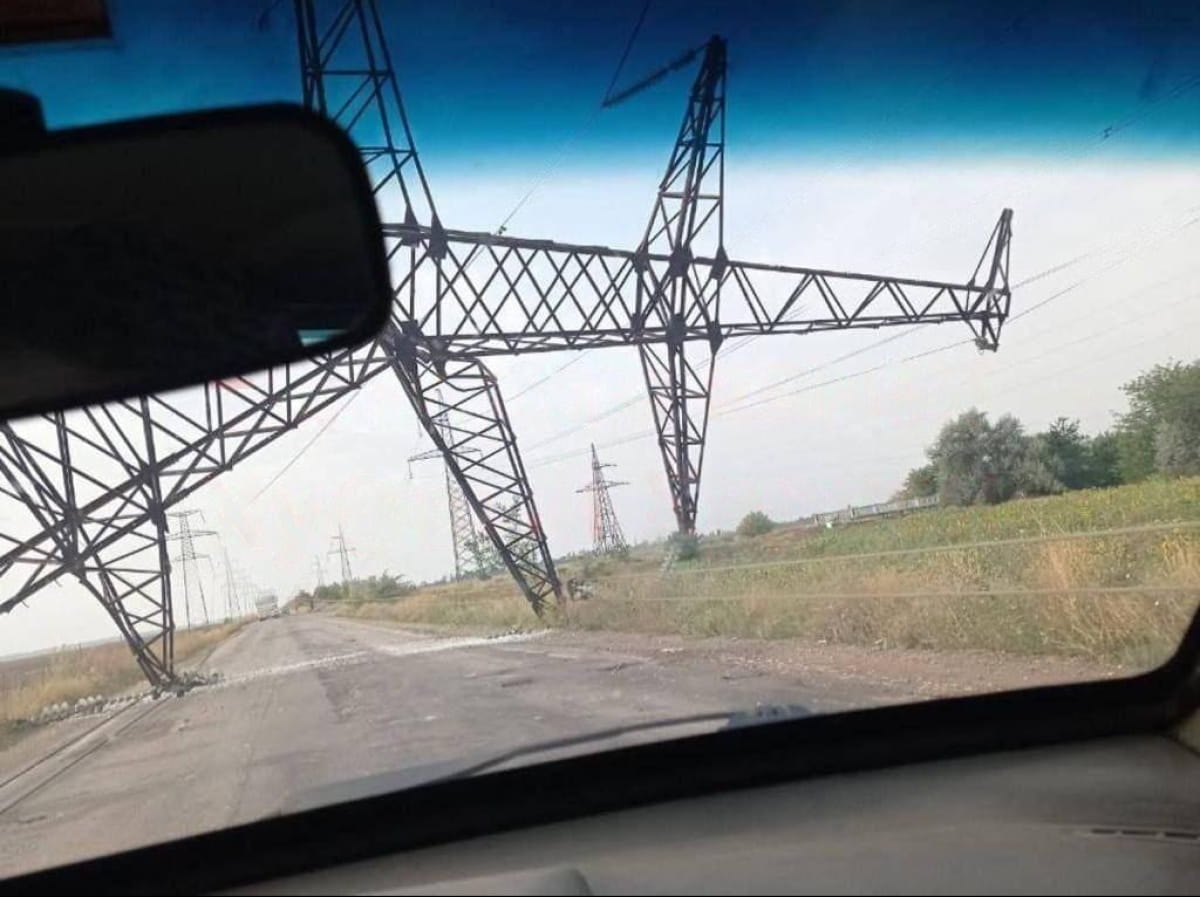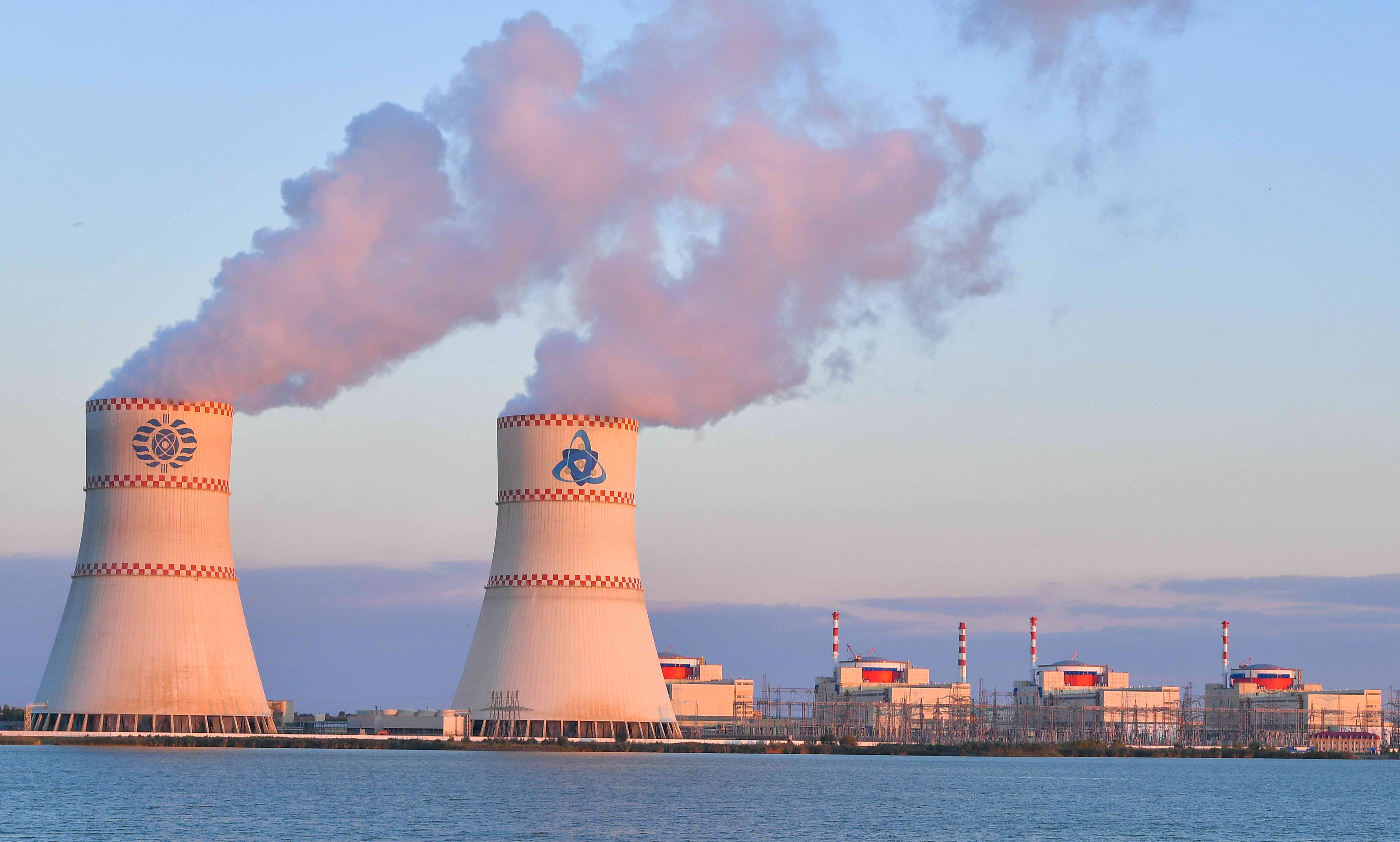Vulnerability to shelling
The Zaporozhye NPP was built in the 80s in the Soviet Union – these are VVER-1000 reactors with pressurized water, if such a reactor is damaged, the primary circuit will be depressurized and the accumulated radioactivity will be released into the environment instead of with water, after which the core cooling will be disrupted and possibly her meltdown.
Statements that not a single projectile can penetrate the station's cap do not correspond to reality, says nuclear physicist Andrei Ozharovsky. The station was built according to Soviet designs, the protective cap can withstand the fall of an aircraft weighing no more than 5.7 tons – this is the An-2 "corncob". The penetrating power of any artillery system is much greater because the shells are designed to penetrate armor. A hit by an artillery projectile with a caliber of more than 150 mm will lead to the destruction of the containment, since this is not an armored cap made of several meters of reinforced concrete, as in military structures, the expert recalls.

Another danger is the storage of nuclear waste on the territory of the ZNPP. These are very dense concrete containers, but chips have already been found on them, says Ozharovsky. These containers contain spent nuclear fuel, which is the most dangerous and highly radioactive. According to Ozharovsky, the destruction of these containers is comparable to the destruction of reactors.
Power outage vulnerability
Under the threat of shelling is not only the station itself, which now has only one power unit, but also the power lines that feed it. Disconnecting the power unit from the grid and shutting down the reactor (“cold shutdown”) is a procedure that is done every year and on every reactor. However, a regular shutdown lasts at least a week under the constant supervision of specialists, and a sharp shutdown of the ZNPP from power can lead to a disaster scenario at Fukushima, says Ozharovsky. Moreover, the power must remain even if the station is put into a “cold shutdown”.
“The reactor does not stop instantly, there is a cooling down period, and there is residual heat release, i.e. energy that is released not due to the fission reaction of uranium or pluton atoms, but due to α- and β-decay in the daughter decay products of all these artificial radionuclides – cesium, strontium and others, of which about two thousand are formed there in the reactor. Although there is no chain reaction, they continue to generate heat in the amount of several percent of the rated power. If the nominal power is 3000 MW and the real power is 1000 MW, then all nuclear power plants have a very low efficiency, then 1% represents tens of megawatts. Thirty megawatts is a huge power, and in order for the reactor not to melt, it needs to be cooled, that is, water is pumped through it, and an external source of electricity is needed to operate the pumps.”
Sudden shutdown of the ZNPP from power could lead to a disaster scenario at Fukushima, says Ozharovsky
If the reactor is in a cold state, then the hit leads to the release of radionuclides, but they lie side by side, as if from a normal hit of a projectile in a warehouse of some chemicals. This is very bad, but there is no release into the high layers of the atmosphere and expansion over several hundred kilometers. But in terms of the duration of pollution, this is also a serious accident – everything in the district is polluted for 300-500 years.
The scenario of an accident with the loss of the final heat sink is well known to nuclear scientists, so there are backup systems at the stations. There are standby diesel generators that must be operational and have sufficient fuel to power pumps and other safety critical systems. But, according to Ozharovsky, one cannot rely on this:
“All this in the current conditions is a big question – did they drain the diesel fuel from them and unscrew some kind of device from them. Now there are questions about the performance of each of these elements. We see a message that power transmission towers have been destroyed, and the nuclear power plant is now located on the same power line, which is unacceptable, because the reserve must be two- and three-fold. These lines are of different capacities, and they could be restored, but if something happens to the remaining one, there will be a threat that the nuclear power plant will be left without an external source of energy. Power lines are very easy to damage, they cannot be hidden, everyone knows where they are, they cannot be protected from saboteurs. If the nuclear power plant loses all power lines, then the reactors must be shut down and the backup diesel generators started, then everything will be fine. If they do not turn on, then it will be what it was at Fukushima, when the generators were simply washed away by a wave. The reactor melted, and the fuel penetrated through the concrete pad into the soil and water.”

Olha Kosharnaya, a member of the Collegium of the State Nuclear Regulatory Inspectorate of Ukraine, thinks that backup generators should still work in this scenario:
“There are a huge number of them, taking into account the lessons of Fukushima. Then the generators flooded there, and they spared the money so that the military brought them. This accident could have been prevented. This is a design basis severe accident with a core meltdown under the condition of loss of external power supply. There are calculations – more than twenty diesel generators are connected, a diesel supply for ten days, in order to prevent the melting of the reactor core.
What happens if an accident does happen
According to Olga Kosharnaya, Energoatom made calculations to assess the consequences of an accident with a core meltdown in the event of a loss of external power supply and water in the primary circuit.
“They calculated on July 27, 2022 that depending on the direction of the wind, humidity, precipitation and temperature, in 6-7 hours the radioactive cloud will go to Romania / Crimea / Bulgaria, in 23 hours it will be Turkey, but the largest fallout will happen in Krasnodar Territory. We operate with numbers, and according to the numbers: cesium-137 at a distance of 350 kilometers from Energodar will fall with precipitation of 100 thousand Bq per square meter at a rate of 400 per square meter. One hundred thousand becquerels per square meter is the exclusion zone. So Russia will get it even if there is a north wind, and the west wind in general will carry everything to Russia and it will be “fun” to the Urals.”
Is it possible to switch the Zaporizhzhya NPP to power the Crimea
The Russian authorities have repeatedly made statements that it is planned to disconnect the captured station from the Ukrainian energy system and redirect power to the captured Crimea. But it's not that easy, says Ozharovsky:
“Now the Ukrainian energy system is out of sync with the Russian one. We have alternating current, and all generators of a particular power system must work synchronously. This does not mean that the system is completely cut off, it means that a direct flow of energy capacities is impossible, so-called direct-flow inserts are required. Roughly speaking, the alternating current of one power system is first converted to direct current, and then re-converted to alternating current, synchronized with another power system. This is not some small device, such an insert is comparable to a switchgear. This is a huge and expensive thing, which, as I understand it, is not now, because before, both power systems of both countries worked together. These things are just not built. Sounds like some sort of fuse, but it's a pretty big energy facility."
The expert notes that only one or two power units without direct-flow inserts can be synchronized with Russia if power lines are restored towards the Crimea or mainland Russia: “They can do it right now, but such lines can be easily destroyed as a result of sabotage. In 2015, such a sabotage was successful – in November, power transmission towers were blown up on the Ukrainian side, through which electricity was supplied to Crimea. After that, the peninsula was minimally powered, a blackout with rolling blackouts every two hours lasted a month, Crimea was finally powered after the completion of the construction of two large thermal power plants and an energy bridge from Russia.

Why does Russia need Zaporizhzhya NPP
Ozharovsky believes that Russia does not need as much electricity as Crimea. The economy is not growing in Russia, energy consumption is not growing, and the existing capacities are more than enough, the expert says. There is the Rostov Nuclear Power Plant, where the fourth power unit was launched relatively recently.
“I was at the hearings in Volgodonsk and they said that there is so much energy that we will supply it to the Crimea. Imagine tossing electricity over a thousand kilometers. In principle, it is possible in the opposite direction, but then what to do with the Rostov nuclear power plant? The same is true of the Lugansk region, Donetsk or Zaporozhye. Now there are no serious consumers, so that there is some kind of industry. Here was Azovstal, a huge consumer of energy, and it no longer exists. Now they have bombed a plant in Kramatorsk, which makes reactors for Russia, and there will also be no consumer, there were energy-intensive metallurgical industries. It's just not the same scale. We need small coal-fired boilers that both heat and produce electricity, like CHPs.
If one of the VVER-1000 reactors of the Zaporozhye nuclear power plant can be connected to the Russian power system, the power line restored and electricity transferred to the Crimea, then one VVER-1000 reactor of the Rostov nuclear power plant will have to be turned off, because energy can somehow be accumulated. Elon Musk knows how to do this, but we don’t know how, but we need to have a balance of production and consumption. Or it is necessary to restore Azovstal or any other large consumer, but it is not there, and it will take years to restore. Here, most likely, these conversations have some other goals than covering some needs.

According to Olga Kosharnaya, Russia needs the seizure of the ZNPP for nuclear blackmail and the unification of the seized capacities into a unified Russian energy system.
“From my point of view, Russia is using this nuclear blackmail and shelling in order to force Ukraine to the negotiating table. Russia's goal is not to cause an accident, it needs a safe operating station. As soon as they entered, they immediately told the staff: “Now there will be a referendum, you will receive passports, you will be employees of Rosatom.” They need not only the Zaporozhye station, but also the Kakhovka hydroelectric power station and industrial wind farms in the south of the Kherson region – that is why they restored the power line from the isthmus to Kakhovskaya. They have an idea – to reconnect not only the Zaporozhye station, but also all the seized capacities to the unified Russian energy system, they have been doing this work since May.”
The shelling on July 11 before the speech of the Chinese representative at a meeting of the UN Security Council (SC) is indicative, Kosharnaya says: “This is all forcing the situation so that our international partners also sit us at the negotiating table in order to approve the status quo on the occupied territories. They have no success on the fronts, they are afraid of an offensive to the south.
Nuclear power plants affected by the war
Until 2011, such “force majeure” events as military operations or an aircraft crash were not taken into account when designing a nuclear power plant, they were considered rather as isolated cases. It was enough to take into account the complete failure of any elements, regardless of the cause. The design guaranteed the safety of the station after such events. Everything was changed by the accident at Fukushima, the probability of which was assessed as insignificant.
Likewise, the likelihood of being affected by the war has also changed. This possibility was underestimated on the grounds that a country with nuclear power is sufficiently developed not to be drawn into a military conflict on its own territory. Reality has shown that this is not the case. And Ukraine was not the only country with a nuclear power plant that found itself in the epicenter of hostilities.
- Station Krsko in Slovenia (water-cooled reactor VVER, 700 MW). In 1991, the station, built jointly by Slovenia and Croatia, which were part of Yugoslavia, was on the collision line. In June 1991, Slovenia declared independence, followed by a 10-day war. Federal troops crossed the border and encountered armed resistance from the local police. The battle took place on a road passing a few kilometers from the nuclear power plant. About 70 people were killed during the conflict. The station continued to operate.
- Bushehr nuclear power plant in Iran (VVER reactor, 1000 MW). Construction began in 1975, but as a result of Western sanctions, it was stopped, as the contractor was the German company Kraftwerk Union. The first block was about 75 percent complete. In 1980, an eight-year war with Iraq began. During this time, the station was subjected to several attacks by the Iraqi Air Force. The lack of nuclear fuel limited the possibility of damage to the plant. However, despite the fact that the containment is built of very thick reinforced concrete, there is evidence that as a result of continued shelling of the object, two through holes with a diameter of about half a meter each formed in the dome of the containment of the second power unit. In 2010, Iranian air defense shot down its own plane, which crashed 20 km from the station. Despite all this, the nuclear power plant successfully passed commissioning tests and was connected to the grid in 2011.
- Bombing of nuclear reactors in Iraq. The first two nuclear reactors, Tammuz 1 and Tammuz 2, were destroyed by Israel in April 1978. The new reactor was built in France in 1980 and delivered to Iraq. It was installed next to a functioning Soviet reactor (IRT-5000, 2 MW) in a newly built underground nuclear center near Baghdad. Israeli intelligence believed that the new reactor was designed to produce plutonium and that military intervention was needed before the reactor could be loaded with nuclear fuel. On June 7, 1981, a group of Israeli fighter jets attacked an Iraqi reactor. Operation Opera, also known as Operation Babylon, damaged the reactor complex beyond repair.
- The destruction of the reactor in Syria. Syria's relationship with Israel has led its nuclear program to the same fate as Iraq's. The Syrian nuclear reactor in Deir ez-Zor was destroyed by the Israeli Air Force – ten aircraft, each of which was equipped with a 500-kilogram warhead, disabled the air defense system with a direct hit and bombed the reactor. The destruction of a research reactor, even an operating one, does not lead to serious radiological consequences due to the small amount of fissile material. In the case of the Syrian reactor not loaded with nuclear fuel, the consequences were to write off the rest of the costs incurred and the collapse of Bashar al-Assad's nuclear hopes.
- Indo-Pakistani conflicts. India has five nuclear power plants versus two in Pakistan. Armed clashes between these countries are most often limited to border conflicts, the reactors are removed from the borders. However, the situation is aggravated by the fact that both countries have directed nuclear weapons against each other. At the same time, the issue of the safety of nuclear power plants in this case fades into the background of a mutual nuclear threat.
- Armenian NPP (two VVER-440 reactors). It suffered hostilities easier than the above stations, the Armenian-Azerbaijani conflict in 1991-1993 did not affect it. The station is located near Yerevan, far from the theater of operations. The nuclear power plant was shut down after a strong earthquake in 1988, but the second unit was recommissioned in 1995. However, the situation with Nagorno-Karabakh remains unresolved.


